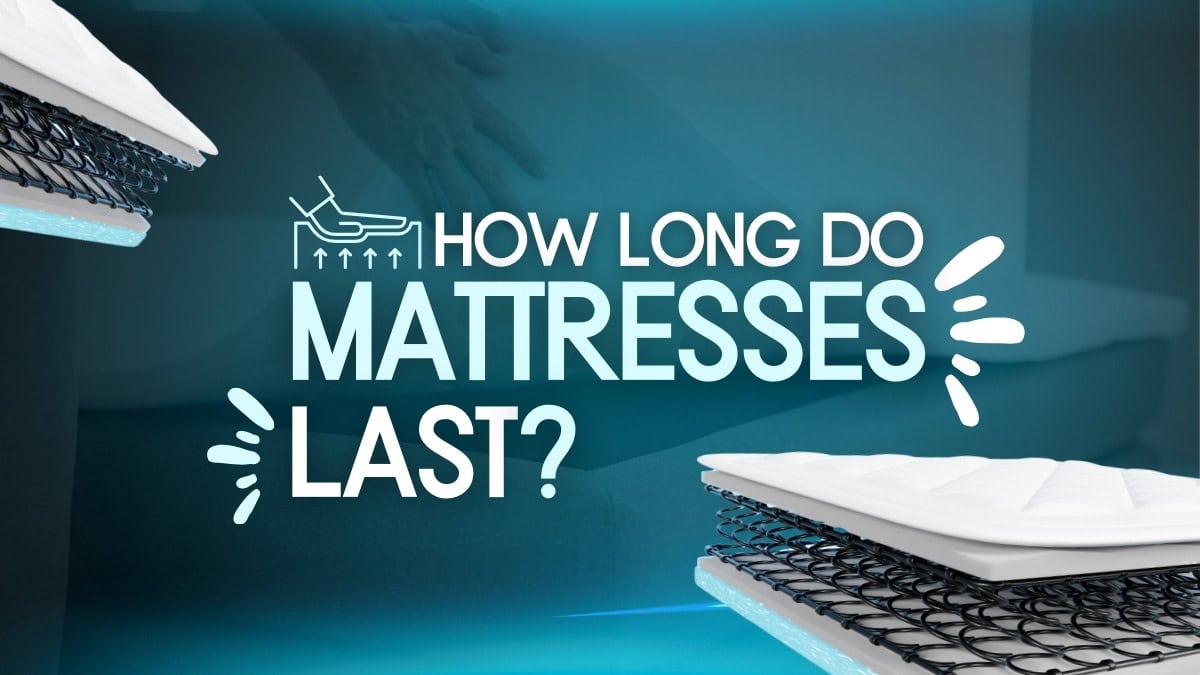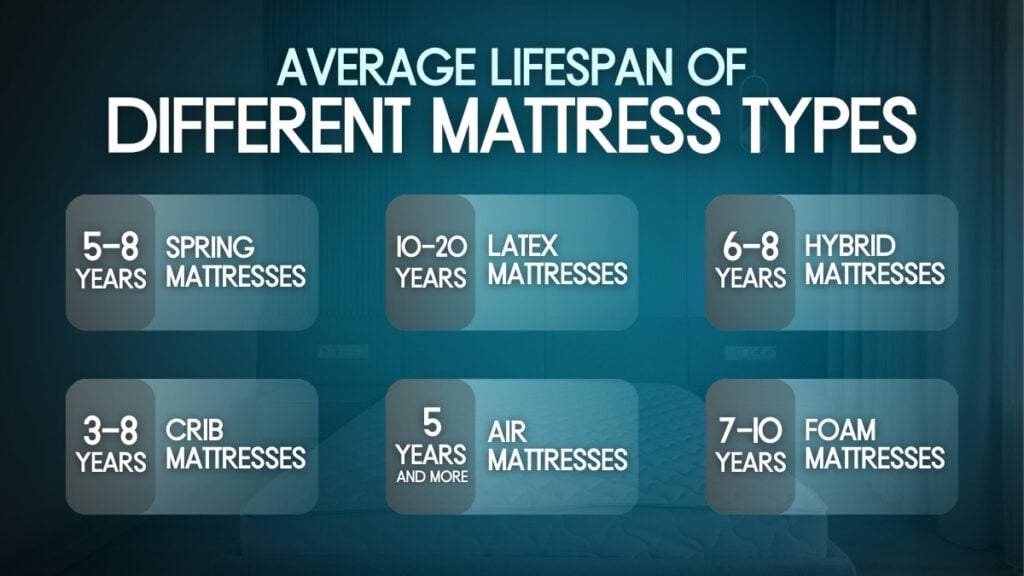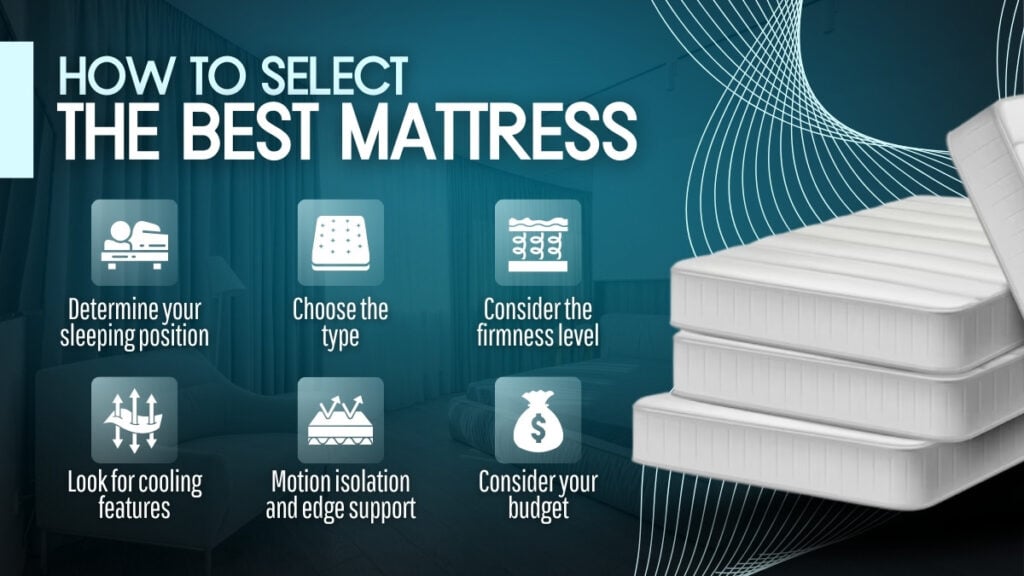
It is estimated that we spend about 30% of our lives sleeping. That means your mattress is a sizable financial investment, as you spend a lot of time on it.
But how long do mattresses last if we’re spending 8 hours on them every night? The common consensus estimates the lifetime of most mattresses to be about 7 to 10 years. That means by retirement age, an average person will have slept through approximately 9 mattresses since childhood.
If you don’t replace your mattress often, a worn-out mattress can sneak up on you and cause back pain, neck pain, and other physical symptoms.
So, let’s examine how to monitor your mattress’s condition and when to replace it before the doctor’s bills start to roll in.
How Long Do Mattresses Last According to Experts?
Mattresses age just like we do. The trick is to know when to retire them before they retire us. With that in mind, let’s take a quick peek at how long different types of mattresses can be expected to last.
The Average Lifespan of Different Mattress Types

- How long do spring mattresses last? 5-8 years.
- How long do latex mattresses last? 10-20 years.
- How long do hybrid mattresses last? 6-8 years.
- How long do crib mattresses last? 3-8 years.
- How long do air mattresses last? 5 years or more, depending on use.
- How long do foam mattresses last? 7-10 years.
Signs Your Mattress Is Wearing Out
Many people won’t notice their mattress is wearing out until they start waking up sore and tired. Therefore, let’s examine some advanced clues that your mattress may be on its way out.
The two big signs your mattress has seen better days are sags and lumps. Sags are noticeable dips in an inch and a half or more of the sleeping surface. Lumps are when the surface of your mattress starts to become noticeably uneven, and small humps start to form.
What Is the Lifespan of a Mattress?
When it comes to how long a mattress lasts, there are various factors to consider such as the type of mattress, sleeping habits, and maintenance frequency.
Memory Foam vs. Innerspring vs. Hybrid
How long do memory foam mattresses last? They last about 8-15 years, depending on the quality of the foam, how well they are supported, and how often they are rotated.
An innerspring mattress is the classic mattress that originally made civilization what it is today. Depending on the quality of the coils, whether they’re individually wrapped or not, and how often the mattress is rotated and cared for, it will all help an innerspring mattress last up to 5-8 years.
Many feel that a hybrid mattress combines the qualities of the best spring and foam mattresses. They have the strong support of springs and the contouring comfort of foam. The average lifespan of a hybrid mattress is 6-8 years, but if it is made of high-quality materials and well cared for, it can last much longer than that.
The Impact of Sleeping Habits and Maintenance
The size of the sleeper, sleeping habits, and how well the mattress is maintained will all significantly impact how long a mattress lasts.
For example, a heavier sleeper or one who tosses and turns will wear down a mattress more quickly than a lighter sleeper who stays in one position. Other things like using a mattress protector, how often the mattress is rotated, and overall cleaning and maintenance will also have a significant effect on the life of a mattress.
Side Effects of Using an Old Mattress
An aging mattress can contribute to a surprising array of health issues.
Poor Sleep Quality and Its Impact on Health
Poor sleep quality or sleep deficiency is a serious problem in the current society, where everyone is constantly on the go. It has not only been linked to numerous chronic health problems like heart and kidney disease, stroke, and depression but also to injuries, car accidents, and large catastrophes such as plane crashes [1].
Allergies, Dust Mites, and Bacteria Buildup
According to an article by Parkway East Hospital, if you experience any of the following in the bedroom or around your sleep experience, you likely have a dust mite allergy [2].
- Difficulty sleeping
- Nasal congestion
- Sinus headaches
- Asthma-like symptoms
- Eczema
Depending on how long you’ve had your mattress and sometimes the type of bed frame you’re using, having these symptoms over some time could be a signal that it’s time for a change.
Back Pain, Joint Pain, and Spinal Misalignment
According to the NorTex Spine & Joint Institute website, the following are some of the common issues with mattresses [3]. These issues may significantly contribute to lower back pain:
- A too-soft mattress that sinks significantly
- Inadequate support and sagging
- A too-firm mattress that creates uncomfortable pressure points
Benefits of Getting a New Mattress
A new mattress can dramatically improve sleep quality and create an environment conducive to more restorative sleep cycles and overall health. Investing in a quality mattress offers numerous physical and mental benefits.
Improved Sleep Quality and Better Support
According to a 2015 study, participants who slept on new medium-firm memory foam mattresses reported a marked decrease in pain or discomfort and said they also fell asleep faster [4].
Overall Health Benefits
According to an article by Revive Chiropractic, some of the additional ways a new mattress can benefit your health besides supporting your back and spine include the following [5]:
- Improved Breathing: A mattress with proper support can improve breathing so that all your vital organs are properly oxygenated while you sleep.
- Better Blood Circulation: Blood mattress support also improves blood flow so that your muscles and organs receive all the nutrients they need to regenerate during sleep.
- Improved Mental Health: A good night’s sleep on a quality mattress will help you feel more rested, less irritable, and intellectually sharper.
Energy Efficiency and Environmental Impact
In these times of potentially catastrophic climate change, a major consideration for modern mattress consumers, especially those considering a bed-in-a-box, is the environmental impact their purchase will have.
It is important to choose a mattress made from natural materials. Organic latex, cotton, and wool are more energy-efficient and environmentally friendly than synthetic materials like polyurethane foam, which can release volatile organic compounds (VOCs) into the environment.
How To Select the Best Mattress
So far, we’ve discussed how long a mattress should last. Now, let’s look at how to select the best mattress for your needs.

Determine Your Sleeping Position
There are 3 major sleeping positions: side, back, and stomach. Knowing which one you prefer is important when it comes to selecting a mattress. Back and stomach sleepers need a firmer mattress for support, and side sleepers need a softer mattress that will contour to their shape.
Choose the Type
Side sleepers usually do best with some type of memory foam or hybrid mattress that can provide adequate pressure relief for their shoulders and hips. Back and stomach sleepers usually do better with hybrid or spring mattresses that can provide the proper support they need.
Consider the Firmness Level
Side sleepers usually need a mattress that is between soft or plush and medium firm to provide the proper pressure relief and contouring they need. Back and stomach sleepers usually need a firmer mattress ranging from medium firm to firm to get the proper support and bounce they need.
Regardless of sleep position, studies show that medium-firm mattresses play a leading role in pain management. This type of surface has been shown to reduce pain in individuals complaining of back pain.
Look for Cooling Features
If you’re a hot sleeper, then you’ll likely need a hybrid mattress that features prominent cooling features like the following:
- A cooling gel memory foam surface to help circulate air
- A ventilated mattress topper that will help wick away sweat and excess moisture
- An individually wrapped coil system to enhance overall circulation
Motion Isolation and Edge Support
If you sleep with a partner, and either one or both of you move around a lot at night, then you need a hybrid mattress featuring superior motion isolation and strong edge support.
The motion isolation feature is made possible by the combination of a respondent memory foam upper layer supported by an individually wrapped coil system underneath. A strong coil system will also provide strong edge-to-edge support, expanding the overall sleep area and allowing you both plenty of room.
Consider Your Budget
Because of their relatively long life in relation to many other products, mattresses can be fairly expensive. Of course, prices will vary considerably based on the size, level of luxury, and features you require. Here are some general price ranges for the various types of mattresses available:
- Foam: $500–$2000
- Innerspring: $700–$1000
- Hybrid: $1200–$2000
- Latex: $1,000–$2000
That said, keep in mind that luxury models can cost more than the highest values in each price range, and some cheap mattress options may cost less than the indicated minimum.
Test Sleep Trials and Warranty
Depending on the make and model you’re interested in, contemporary mattresses have sleep trials that can range from 60 days to a full year and warranties between 10 years and a lifetime.
Expert Insights
While mattresses don’t come with an expiration date, experts like Lauren Fountain, a certified sleep science coach and senior product editor at SleepFoundation.org, also came to the same conclusion as the general consensus that most mattresses have a lifespan of 7 to 10 years. However, various factors can influence a mattress’s longevity, including its initial quality, materials used, and even the sleeper’s weight and sleep habits [6].
It’s crucial to recognize that a mattress’s comfort and support directly impact sleep quality. As David Rubin–another certified sleep science coach–pointed out, “A deteriorating mattress can lead to poor sleep, aches, and pains [7].”
He recommended evaluating your mattress regularly by asking yourself trivial but consequential questions like: “Do I wake up feeling tired?” or “Has my mattress started sagging?” If the answer is yes, David suggested it might be time for a replacement, even if it hasn’t reached the 7-10 year mark [7].
FAQs
Here are some frequent questions that customers have been asking regarding how long mattresses last.
What Happens to a Mattress After 10 Years?
After a decade of use, the average mattress will start to show significant signs of deterioration, including sagging, decreased support and comfort, and noticeable surface wear and tear.
Can a Mattress Last 20 Years?
A high-quality mattress made of durable material like natural latex could last for 20 years, but that is highly unlikely since, after that much use, the materials and structure would likely have lost much of their bounce and strength.
How Do You Know if Your Mattress Is Worn Out?
You can recognize that your mattress is worn out if it starts to sag, shows significant lumps on its surface, or develops noticeable indents where you typically sleep. Another tell-tale sign is if you wake up sore or stiff or if you are starting to experience allergic symptoms each morning.
When To Get Rid of Mattress?
You should consider replacing your mattress when you start to experience any combination of the following:
- Visible sagging or lumps
- Noticeable damage like stains or tears
- You’re waking up every morning stiff or in pain
- You experience allergic symptoms every night or morning
How Long Do Tempur-Pedic Mattresses Last?
Tempur-Pedic is one of the best-known mattress brands. It comes with a 10-year full replacement warranty, and if it’s been well cared for, its usual lifespan is approximately 10-15 years.
How Long Does a Mattress Topper Last?
The lifespan of a mattress topper can vary significantly depending on several factors, primarily the materials used and how well it’s cared for. However, you can expect a mattress topper to last between 3 to 5 years.
How Long Do Purple Mattresses Last?
Purple mattresses are designed to last roughly 7 to 10 years. This lifespan is supported by their 10-year warranty. The unique GelFlex Grid contributes to their durability.
How Long Do Nectar Mattresses Last?
Nectar foam mattresses typically last between 7 and 10 years. Hybrid models may last slightly longer. Factors like usage and care influence this. Nectar also offers a lifetime warranty.
How Long Do Casper Mattresses Last?
Casper foam mattresses typically last between 7 and 10 years, while hybrid models may last slightly longer, often 8 to 10 years. Proper care, such as rotating the mattress, can help maximize its lifespan.
How Long Should a Mattress Last Before Sagging?
A quality mattress should generally last 6 to 8 years before significant sagging occurs. Mattress type, usage, and care greatly influence this timeline. Visible indentations or a loss of support indicate it’s time for an upgrade.
How Long Do Mattresses Last? Final Thoughts
Mattresses, like our cars and pets, don’t generally last as long as we do, but they do stick around long enough so that we forget about replacing them. When cars go, they inconvenience us, pets break our hearts, and mattresses cause us to wake up in pain.
But it doesn’t have to be that way (at least with mattresses).
We began this article by saying life is about maintenance, yet the secret to knowing when to replace a mattress is not about maintaining the mattress but about yourself. The first time you wake up with stiffness or pain, it’s time to start shopping for a new mattress.
So, how long do mattresses last realistically? They last as long as you’re waking up refreshed and feeling healthier and more energetic, but after a decade, you might have to just get another one regardless of the quality of your sleep. Why? Sometimes, we sit in discomfort for too long, and it becomes the new normal.
 11 Niche Experts
11 Niche Experts
 100+ Product Reviews
100+ Product Reviews
 50+ Tested Products
50+ Tested Products
At BestDaily, our mission is simple: to help you make confident, informed decisions about the products that impact your daily life. Whether you're searching for wellness essentials or lifestyle upgrades, we combine hands-on testing with expert analysis to highlight what truly works.

